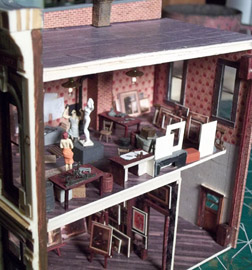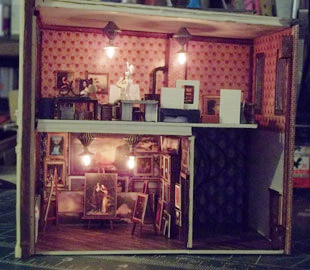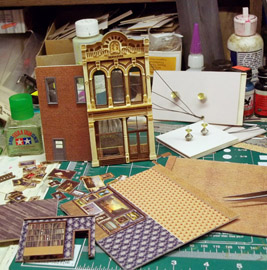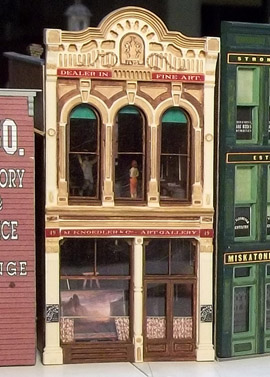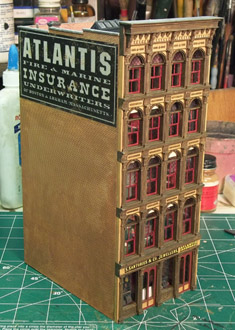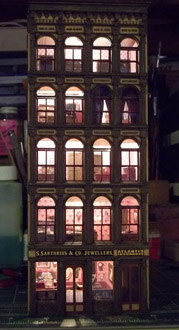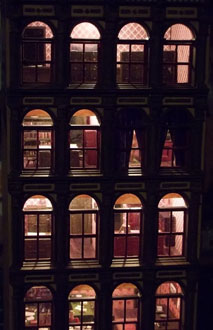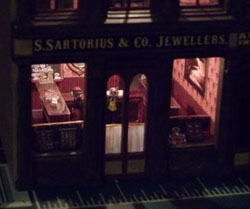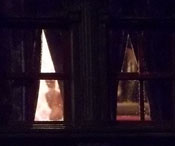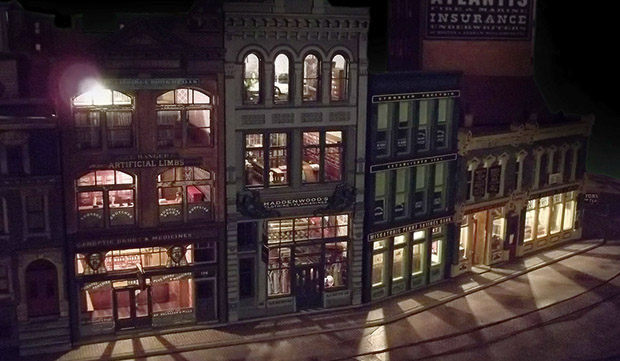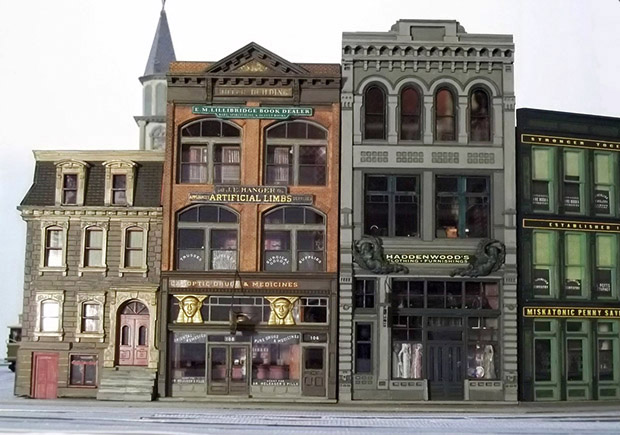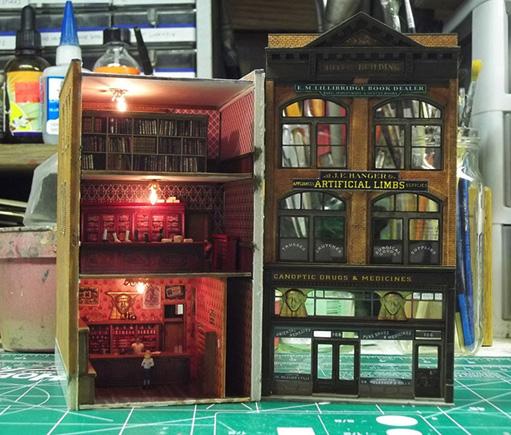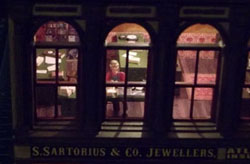The Atlantis Insurance building is a wonderful ironfront kit from City Classics. It also is reminiscent of downtown Salem's 1873 Hale Building. I gave the structure double-hung windows. Walls are pinned in place with the back and right side removable in case I need access to the interior in the future.
A tall building like this is going to be a focal point; I had to give it detailing and lighting for each floor.
The ground floor jeweller's shop featured glass display cases made from styrene with lots of little sparkly dots painted on the black cardboard cushions inside. The floor above held the diamond-setter and clock-repairer.
The insurance company occupied the top three floors— with cardboard-scrap desks and filing cabinets made from short lengths of 1/4" square balsa.
The Miskatonic RR is intended to be run in the dark— I have visions of well-lit passenger trains passing from shadow through pockets of moonlight and artificial illumination, then back into shadow again. Internal lighting is going to be a big feature of the buildings I construct for the city of Arkham, and that means lots of detailed interiors. Who wants to look through a well-lit window into an empty room? In blocks of storefronts like the one here, each business has to have its own character— and tell its own story.
Much of the detailing I add to my structures comes from signs, posters, ads, textures, and patterns found on the internet. With Photoshop to help me, I scale things to HO size and gang them together for laserprinting. Wood and tile floors, wallpaper, wainscotting, rugs, ceilings, awnings and old signage are obvious candidates. The late 19th century was a golden age of advertising. I try to leave no walls unpostered or unsigned.
Lighting comes from 12-volt grain-of-rice bulbs. A variety of beads and cheap jewelry settings from the craft store provide me with light shades and fixtures.
Click on the pictures for enlargements.
The art gallery has its showroom on the ground floor. Upstairs is the atelier of Pickman the academician, chipping away at his latest sculpture while unfinished oil paintings are scattered about the room.
Pickman, his red-haired model, and the statue are Preiser castings. Other than a few cast chairs and barrels, the rest of the details are junkbox pieces plus scraps of paper, wood, styrene, and cardboard. And about 50 laserprinted oil paintings sized to HO.
The facade of the art gallery is another resin casting from Chooch. The rest of the walls, floors, and roof are crescent board with printed overlays. Ceilings are double-layered to hide the wiring.
In keeping with my Lovecraftian theme, there's also a shrine to the Great Old Ones on the fourth floor. (The black curtains are a dead giveaway.) I suppose that some place like this is where most insurance companies divine their actuarial tables.
Peeking inside, the viewer will see something very... um... eldritch. (A nude Preiser figure and a Cthulhu statuette from a board game.)
The two middle facades were cool resin castings from Chooch— just the facades. The rest of the building was built from 1/4" foam-core walls and brick paper overlays. (A few leftover resin and styrene brick walls were salvaged from old projects.) Interior walls were covered with Victorian wallpaper. Floors got wood plank overlays.
E. M. Lillibridge, the book dealer, is a character from Lovecraft's The Haunter of the Dark. The sign for J. C. Hanger's Artificial Limbs was a real sign at one time— got it from an old photograph. The Canoptic Drug Store is decorated with brass mummy masks found in a crafts store.
Shelves, counters, desks, and cabinets were made from images swiped off the internet, pasted together and sized in Photoshop, and printed on a laserprinter. The overlays were glued to scraps of wood and cardboard and assembled into furniture.
You have to look through the side window into the bookstore when the lights are on to see the strange tentacled figure lurking between the shelves. The joke with the artificial limb shop is that it's on the second floor. As for the quality of the drugs in an age before the FDA— well, we'll leave that to the imagination. The young customer is buying some of Dr. Meleager's Pills.
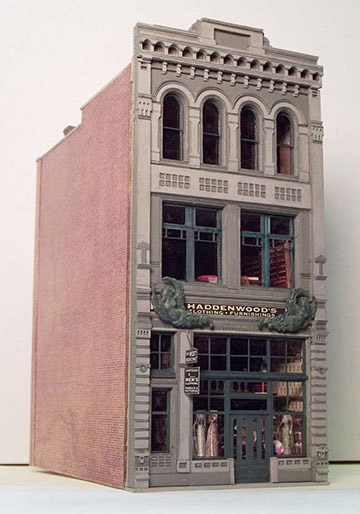
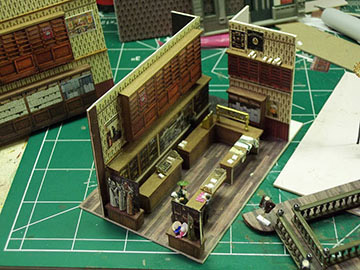
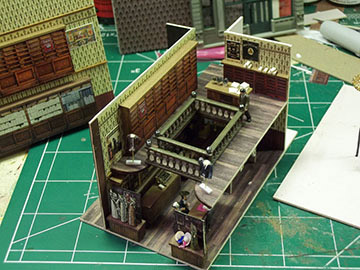
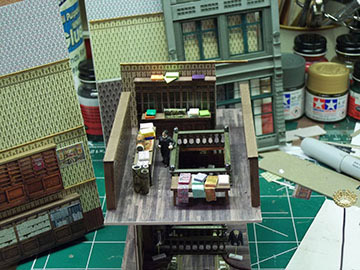
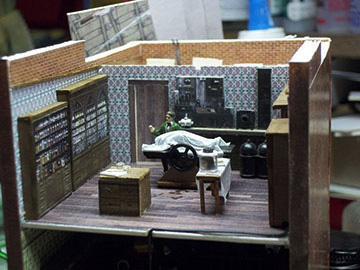
Haddenwood's Clothing & Furnishings has more foam-core walls and cardstock floors and ceilings behind the Chooch facade. The bronze angels above the entrance are more discoveries from the crafts store.
The pictures at left show how the floors are built up as a series of shadowboxes— just enough detail to provide interest to viewers peeking in the windows.
The building was renamed "Blackwood's" after it was installed.
Bottom floor has window displays and customers at the sales counter. The walls are lined with shelves and boxes of merchandise— all printed.
The mezzanine has men's furnishings. . . The railings are from Plastruct. The wiring for the floors runs up the space behind the back wall.
The floor above is the fabric and pattern shop, with bolts of fabric . . .
And the top floor has been rented out to Dr. Herbert West, who figured in several Lovecraft stories as the "Re-animator." That's Doc West in the green coat, with a body on the slab and a head in the jar, ready for his night's work . . .



